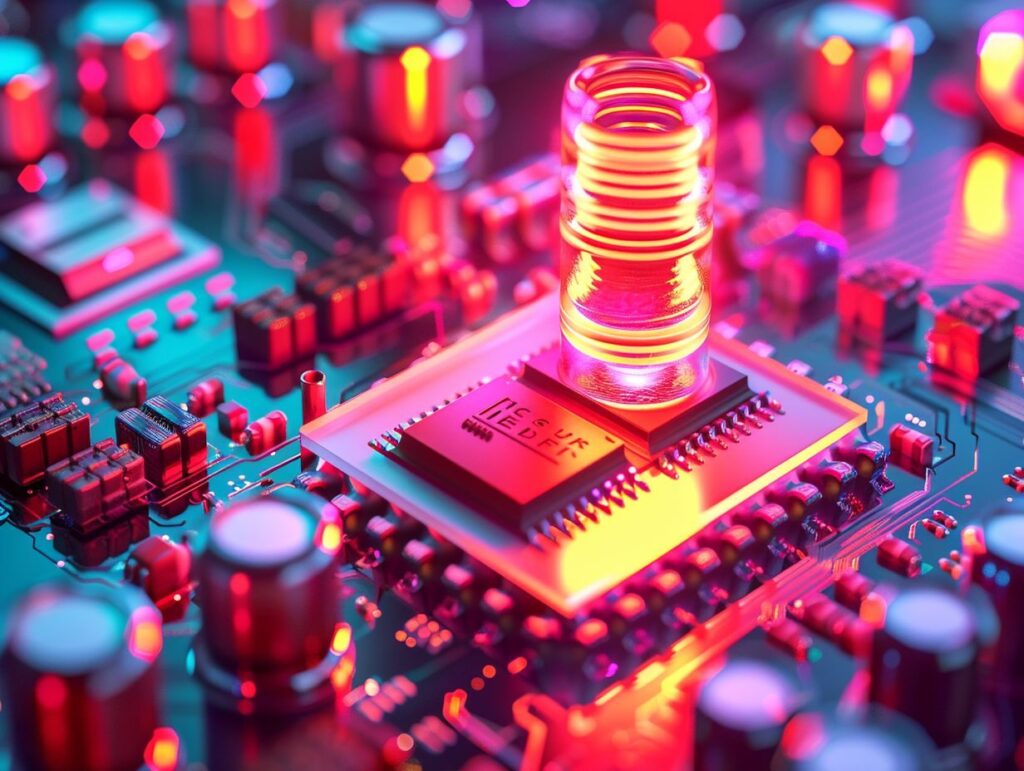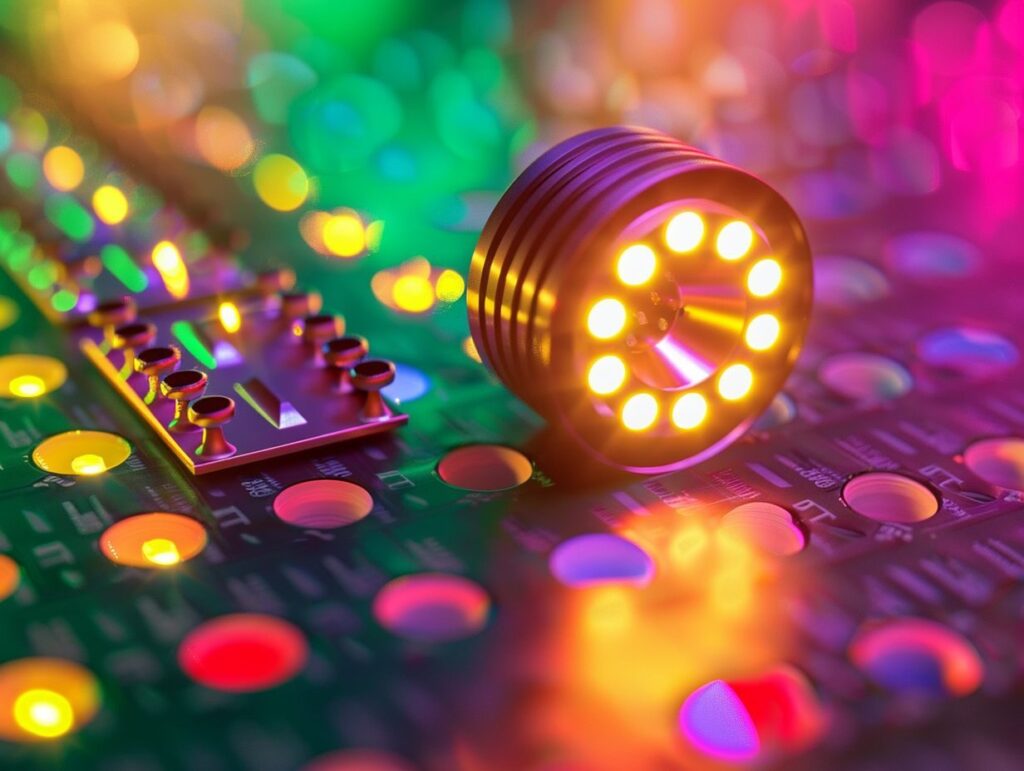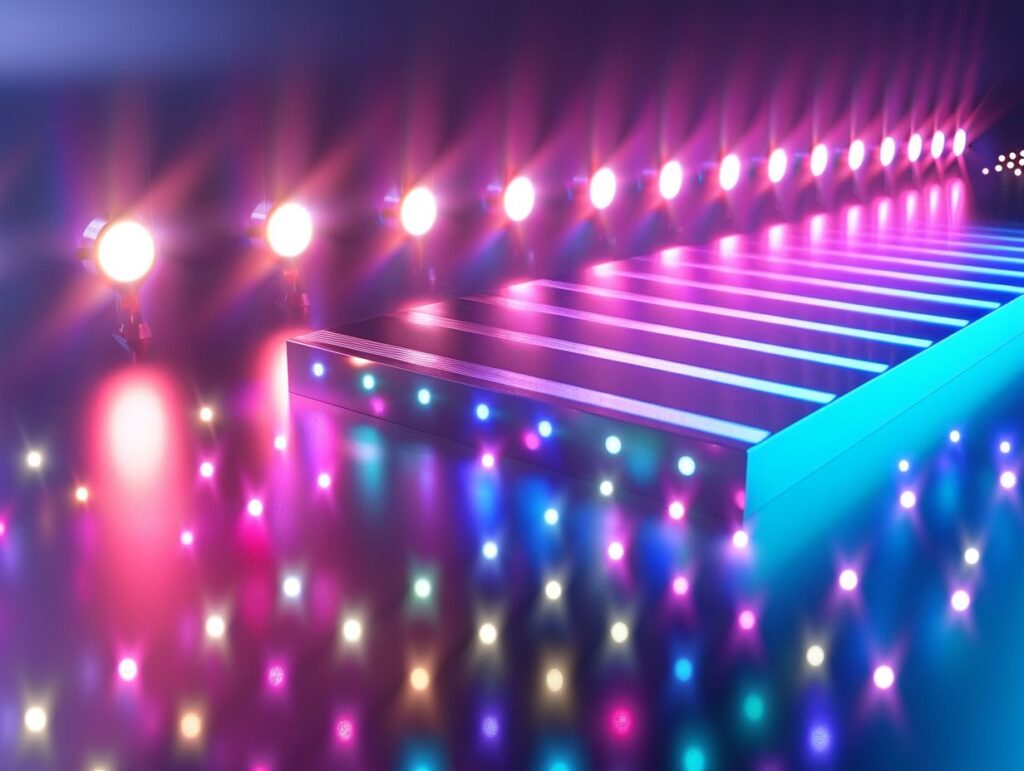Key Takeaways
- LED and photodiode are two different types of electronic components used for light emission and sensing respectively.
- The main differences between LED and photodiode lie in their function, material, direction of current flow, light emission, sensitivity, power consumption, and cost.
- When choosing between LED and photodiode, consider the specific application and requirements, as well as the advantages and disadvantages of each component.
What is LED?

An LED (Light Emitting Diode) is a semiconductor device that emits light when an electrical current passes through it.
The principle of operation of an LED is based on the electroluminescence phenomenon, where light energy is produced from electrical energy at the PN junction.
LEDs are made from different semiconductor materials like gallium arsenide, indium phosphide, silicon, or germanium.
In an LED, the PN junction plays a crucial role in light emission.
When electrons and holes recombine at this junction, energy is released in the form of photons, resulting in light production.
The materials used in manufacturing LEDs determine their efficiency and color output.
For instance, gallium nitride-based LEDs emit blue and green light.
The transition of electrical energy into light energy occurs due to the movement of charge carriers within the semiconductor material.
As electrons move across the PN junction, they release energy in the form of light, creating illumination.
LEDs find applications in various sectors such as lighting, displays, automotive lighting, and communication devices.
Their energy efficiency, long lifespan, and compact size make them popular choices for these applications, replacing traditional lighting sources in many instances.
What is a Photodiode?
A photodiode is a semiconductor diode that converts light energy into electrical energy.
In a photodiode, the PN junction absorbs photons, leading to the generation of electron-hole pairs through photo-conductance.
Photodiodes are commonly made from materials like gallium arsenide, indium phosphide, silicon, or germanium.
When light photons strike the PN junction of a photodiode, the energy they carry is transferred to the bound electrons in the material, liberating them and creating electron-hole pairs.
This process effectively generates an electrical current proportional to the incident light intensity, making photodiodes essential in light detection and measurement applications.
One of the key benefits of photodiodes is their high speed and sensitivity, making them ideal for various applications such as light detection, medical instruments, optical communication systems, remote control systems, and even automotive equipment.
How do LED and Photodiode Work?
LEDs and photodiodes work based on the recombination of electrons and holes at the PN junction of a semiconductor.
When an LED is forward-biased, it emits light due to electron-hole recombination, while a photodiode, when reverse-biased, generates a current proportional to the incident light intensity.
Both devices exhibit dark current in the absence of light.
What are the Uses of LED and Photodiode?
LEDs find diverse applications in areas such as lighting, displays, automotive lighting, and indicators, offering energy-efficient illumination solutions.
Photodiodes are commonly used in light detection, optical communications, barcode scanners, and solar cells, converting light signals into electrical signals with high sensitivity.
LED Applications
LEDs are extensively used in lighting applications, including residential, commercial, and automotive lighting.
They are also employed in displays such as TVs, smartphones, and digital signage due to their energy efficiency and durability.
In the context of general lighting, LEDs offer significant advantages over traditional lighting sources. With their directional lighting capability, LEDs can be easily focused where needed, reducing light wastage.
LEDs have a long lifespan, resulting in reduced maintenance costs and lower energy consumption.
Regarding decorative lighting, LEDs provide versatility in color changing and dimming options, allowing for dynamic lighting designs.
Their small size and low heat emission make them ideal for intricate and compact lighting fixtures.
In display technologies, LEDs are preferred for their high contrast ratio and color accuracy, enhancing the viewing experience.
The ability of LEDs to be dimmed and brightened quickly adds to their appeal in display applications.
Specialty lighting applications benefit from LEDs’ flexibility in design and efficiency in customized lighting solutions.
LEDs can be integrated into specialized fixtures for niche lighting requirements, such as architectural accent lighting or medical lighting.
Photodiode Applications
Photodiodes are crucial components in light detection systems, optical communication networks, remote controls, and medical instruments.
They play a key role in barcode scanners, security equipment, and industrial automation for precise light sensing.
In the automotive industry, photodiodes are utilized in rain sensors that automatically trigger windshield wipers when water droplets are detected, enhancing driving safety.
In consumer electronics, they enable automatic brightness control in smartphones and TVs, offering users comfortable viewing experiences.
In the field of agriculture, photodiodes are integrated into soil moisture sensors to optimize irrigation systems, leading to efficient water usage and better crop yields.
In the aerospace sector, photodiode arrays are employed in satellite communication systems for data transmission and reception.
Differences between LED and Photodiode

LEDs and photodiodes differ in their primary functions: LEDs emit light when forward-biased, while photodiodes generate current when reverse-biased.
LEDs consume electrical energy to produce light, whereas photodiodes convert light energy into electrical signals.
Sensitivity, power consumption, and cost are key distinctions between these two semiconductor devices.
LEDs, Light Emitting Diodes, are widely used in various lighting applications due to their ability to emit light efficiently when a forward voltage is applied.
On the other hand, photodiodes operate in the opposite manner, converting incident light into electrical current.
An important point to note is that forward-biased LEDs do not generate any current, unlike reverse-biased photodiodes.
The different light emission mechanisms play a crucial role in their applications.
LEDs rely on electron-hole recombination to emit photons, resulting in visible light output, while photodiodes utilize the photovoltaic effect to generate current, making them ideal for light detection and sensing.
Function
The fundamental function of an LED is to emit light when a forward bias voltage is applied across the PN junction, whereas a photodiode’s primary function is to convert incident light into electrical current when reverse-biased.
LEDs are active light sources, while photodiodes act as light detectors.
LEDs, or Light Emitting Diodes, are semiconductor devices that emit light through a process called electroluminescence. When electrons recombine with electron holes within the semiconductor material, photons are released, generating light.
This phenomenon is why LEDs are commonly used in lighting applications such as displays, indicators, and even general illumination.
On the other hand, photodiodes work in the reverse manner by converting light energy into electric current when photons strike the PN junction.
This conversion process is crucial in various fields, including optical communication, ambient light sensing, and solar energy harvesting.
Material
LEDs and photodiodes can be fabricated using various semiconductor materials such as gallium arsenide, indium phosphide, silicon, or germanium.
The choice of material influences the device’s performance characteristics, spectral sensitivity, and efficiency.
For instance, gallium arsenide, known for its high electron mobility, is commonly used in high-frequency applications like microwave integrated circuits.
On the other hand, indium phosphide offers excellent optical properties, making it ideal for photodetectors in fiber optics communication systems.
Silicon, being abundant and cost-effective, is prevalent in consumer electronics for its versatility.
Meanwhile, germanium exhibits low-noise characteristics and is utilized in infrared sensors and communication systems.
Direction of Current Flow
In LEDs, the current flows from the anode to the cathode when forward-biased, resulting in light emission.
Conversely, in photodiodes, the current flows from the cathode to the anode when reverse-biased, generating a photocurrent proportional to incident light intensity.
For example, in an LED, forward biasing allows electrons and holes to recombine at the junction, releasing energy in the form of photons, which produces light.
This unidirectional flow ensures efficient conversion of electrical energy into light energy.
On the other hand, in a reverse-biased photodiode, the light-generated carriers create a current flow, making it a key component in light detection applications.
Light Emission
LEDs emit light when electrons recombine with holes at the PN junction during forward biasing, producing visible light or infrared radiation.
In contrast, photodiodes absorb photons and generate electrical current when reverse-biased, facilitating light detection.
LEDs operate based on the principle of electroluminescence, where the energy released in recombination generates photons, producing light.
The wavelength of light emitted depends on the bandgap of the semiconductor material used in the LED. For example, red LEDs have a longer wavelength than blue ones.
On the other hand, in photodiodes, incident photons create electron-hole pairs that generate a current flow, enabling light sensing in devices like digital cameras, solar cells, and optical communication systems.
The efficiency of these processes determines the performance of LED displays, indicator lights in electronics, and photovoltaic cells in solar panels.
Sensitivity
Photodiodes exhibit high sensitivity to incident light levels, allowing them to detect subtle changes in illumination.
LEDs, on the other hand, are not primarily designed for sensitivity but focus on efficient light emission and brightness control.
Power Consumption
LEDs are known for their energy efficiency and low power consumption compared to traditional lighting sources.
Photodiodes consume minimal power when generating photocurrent in response to incident light, making them suitable for low-power sensor applications.
LEDs have significantly lower power requirements than incandescent and fluorescent bulbs, making them a popular choice for energy-conscious consumers.
For example, a 10-watt LED bulb can produce the same amount of light as a 60-watt incandescent bulb.
This substantial energy-saving benefit not only reduces electricity bills but also contributes to environmental sustainability by lowering carbon emissions.
Similarly, photodiodes exhibit high efficiency in converting light into electrical signals with minimal power consumption.
For instance, in solar cells, photodiodes can convert sunlight into electricity with efficiency rates exceeding 20%.
This low power consumption makes them ideal for applications such as light sensing in smartphones, solar panels, and automatic lighting systems.
Cost
In general, LEDs are cost-effective lighting solutions over the long term due to their energy efficiency and durability, despite higher initial costs.
Photodiodes are relatively low-cost components used in various light sensing applications, offering value in precision detection systems.
LEDs, while requiring a higher upfront investment, prove to be economical choices in the long run due to their significantly lower energy consumption and extended lifespan.
The initial cost may be a deterrent for some, but the reduced energy bills and maintenance expenses make LEDs a wise investment.
On the other hand, photodiodes present a different cost dynamic. While they are inexpensive components, their value lies in their precision and accuracy in light sensing applications.
This makes them invaluable in industries like automotive, healthcare, and security, where consistent and reliable data collection is crucial for operations.
Which One Should You Choose?

The choice between an LED and a photodiode depends on the specific application requirements. Select LEDs for lighting, display, and signaling needs where light emission is crucial.
Opt for photodiodes in light detection, optical communication, and sensing applications where converting light signals into electrical signals is essential.
For instance, in a scenario where you need to illuminate a room or create vibrant visual displays, LEDs are the ideal choice due to their efficiency and brightness levels.
On the other hand, if you are designing a light sensor for detecting ambient light levels for automatic lighting control systems, a photodiode would be more appropriate.
Consider the wavelength range required for your application, as different types of LEDs emit light across various spectrums.
Photodiodes are sensitive to specific wavelengths, making them suitable for precise light measurement tasks.
How to Use LED and Photodiode Together?
LEDs and photodiodes can be integrated for optical switching, where the LED controls the light source and the photodiode detects the presence or absence of light.
In optical isolation applications, LEDs and photodiodes provide electrical isolation while transmitting optical signals.
Additionally, in light sensing systems, photodiodes convert light signals modulated by LEDs into electrical signals for further processing.
Optical Switching
In optical switching setups, an LED serves as the light source that can be turned on or off to control the illumination, while a photodiode detects the light presence or absence to trigger specific actions or responses.
LEDs, or Light-Emitting Diodes, are semiconductor devices that emit light when an electric current passes through them.
This emission of light is harnessed in optical switching systems to transmit data or signals.
On the other hand, photodiodes are semiconductor devices that convert incoming light into electrical current.
When integrated with LEDs, the combination enables precise switching mechanisms in a variety of applications.
One common application of optical switching is in telecommunications networks, where optical signals need to be routed efficiently.
By using LED and photodiode pairs, signals can be switched between different paths without the need for traditional electronic switching components.
This method not only increases speed but also reduces electromagnetic interference.
Another domain where optical switching finds utility is in medical equipment such as endoscopes.
Here, the capability of LEDs to provide focused illumination and photodiodes to sense the reflected light aids in achieving clear visualization during medical procedures.
Optical Isolation
Optical isolation involves the use of LEDs and photodiodes to transmit data or signals optically while providing electrical isolation between input and output circuits.
LEDs convert electrical signals into light, which is then detected by photodiodes to recreate the original signal at the output.
One of the key advantages of optical isolation is its ability to eliminate ground potential differences and reduce electromagnetic interference in systems, enhancing overall safety and performance.
For instance, in industrial applications, where high voltages and noise can pose risks to sensitive electronic components, optical isolation plays a crucial role in protecting equipment and ensuring reliable operation.
By utilizing LED and photodiode pairs strategically, engineers can design robust circuits that maintain signal integrity even in challenging environments.
Light Sensing
In light sensing applications, LEDs illuminate the target area, and photodiodes detect the reflected or transmitted light to measure ambient light levels or detect objects.
The photodiode converts the light signals into electrical signals for processing and analysis.
LED-photodiode combinations play a vital role in light sensing systems by enabling precise and reliable detection of light variations.
LEDs serve as the essential light sources, providing controlled illumination that allows photodiodes to accurately capture the light signals.
This interaction is crucial in applications such as proximity detection, where the distance between an object and the sensor is determined by the reflected light intensity. In object recognition, the LED-photodiode setup aids in identifying specific objects based on their reflection patterns.
Ambient light control systems utilize this technology to adjust lighting conditions based on environmental brightness levels.
Frequently Asked Questions
What is the difference between LED and photodiode?
LED (light-emitting diode) and photodiode are both electronic components used in circuit design, but they serve different purposes. LED emits light while photodiode detects light.
How does an LED work?
An LED is a type of diode that emits light when a current passes through it. The movement of electrons in the diode causes it to release energy in the form of photons, which produces light.
What are the applications of LEDs?
LEDs are commonly used in lighting, displays, indicators, and electronic devices such as TVs and smartphones. They are also used in automotive lighting, streetlights, and traffic signals.
What is a photodiode used for?
A photodiode is a type of semiconductor device that converts light into an electrical current. It is commonly used in light sensors, optical communication systems, and solar cells.
How are LEDs and photodiodes made?
Both LED and photodiode are made of a semiconductor material such as silicon or gallium arsenide. The difference lies in their doping process, where LEDs are doped to create a p-n junction for current flow, while photodiodes are doped to create a photosensitive region for light detection.
Can an LED be used as a photodiode?
Yes, an LED can also be used as a photodiode by reversing the direction of the current flow. In this mode, an LED can detect light and produce a small voltage, but it is not as sensitive as a dedicated photodiode.
